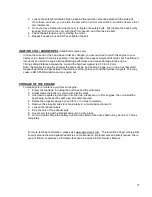
5
If you use a large propeller, engine cooling is reduced at higher speeds. It is advisable to use a CHT /
EGT gauge and probe to monitor engine temperature during operation.
Periodically remove, inspect and balance the propeller. An unbalanced propeller, even slightly, creates
micro-vibrations which are not felt by the pilot, but can lead to premature engine wear and breakages.
A spinning propeller has significant mass and a considerable amount of inertia. When changing speeds,
do NOT rapidly vary the throttle speed up and down, but instead use a steady rhythm to increase or
decrease the engine. Rapid speed changes can cause wear to the reduction pulley bearings, engine and
belt in addition to possibly deforming the mounting holes of the propeller.
Once you have properly tuned your engine, do NOT modify it unless you will be flying in a location that is
significantly different in altitude, climate or temperature from your typical location.
Do NOT fly
in bad weather conditions, you’ll fly the day after. REMEMBER: FLIGHT IS FOR FUN, NOT
FOR RISKING YOUR LIFE! HAVE A GOOD FLIGHT AND ENJOY YOURSELF.
PREFLIGHT / POSTFLIGHT SAFETY CHECK
IMPORTANT!: BEFORE FLYING CHECK ALWAYS EVERY PART OF YOUR CRAFT FROM ENGINE
TO FRAME.
Check the following components and their condition:
Electric wires
Leaks from fuel hoses and fuel tanks
Carburetor and
engine’s crankcase
Propeller is not damaged or loose
Exhaust pipe for cracks
Muffler mounts and condition
Frame is not bent or broken
Rubber mounts are not cracked
Reduction belt is not loose
Safety wire is securely holding components
All bolts / fasteners are tight
Safety netting
Harness and bindings.
ASSEMBLY:
The CORS-AIR M 25 Y engine can be installed on a sturdy frame by using 4 rubber mounts of 40 mm
between the back flange and the engine mount. It is suggested to install also the 5
th
rubber mount
(20x30), fixing it in the proper hole located under the reduction flange through an angular square. This
additional mount will help to distribute the vibrations of the engine evenly across the frame.
To attach the propeller, use only bolts of class 10/8 (100 Kg) and make sure that they are long enough to
pass through the redactor pulley. Tighten the 6 bolts M8 in a cross, at 1.5 Kg.m.(15Nm). Re-check the
torque of all mounting bolts after the first hour of engine use.
To connect the fuel tank to the carburetor, use a fuel hoes with the proper length (no greater than 7.2cm
times the max fuel consumption per hour. For example: if the engine consumes a maximum
11 liters/hour). The length of the fuel line must not be more than 79 cm. (11x 7.2 = 79.2 cm)
It is advisable to install a manual primer bulb to get the fuel to the carburetor before for starting. This
device will allow the fuel to arrive to the carburetor.






































